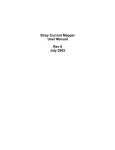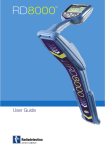Download Precision Pipeline Locator System User Guide
Transcript
Precision Pipeline Locator System User Guide Rev 0 04.2001 Precision Pipeline Locator System User Guide Precision Pipeline Locator System User Guide TABLE OF CONTENTS Title… SAFETY NOTES INTRODUCTION ........................................................................................................................................... 1 PPL RECEIVER ............................................................................................................................................ 1 PPL BAR ..................................................................................................................................................... 1 PCM TRANSMITTER ..................................................................................................................................... 1 PPL RECEIVER FEATURES........................................................................................................................ 2 RECEIVER BATTERY REPLACEMENT .............................................................................................................. 2 PPL RECEIVER OPERATION ......................................................................................................................... 2 ON/OFF ....................................................................................................................................................... 2 DEFINE PIPE DIAMETER SCREEN .................................................................................................................. 3 PIPELINE LOCATE MODE ............................................................................................................................... 3 DISPLAY CONTRAST ..................................................................................................................................... 4 MENUS ........................................................................................................................................................ 4 SYSTEM UTILITIES...................................................................................................................................... 5 UPLOAD DATA LOG ...................................................................................................................................... 5 DOWNLOAD SOFTWARE UPGRADE ................................................................................................................ 6 RESTORE SYSTEM DEFAULTS ....................................................................................................................... 7 SELF-TEST .................................................................................................................................................. 7 USER PREFERENCES SCREEN ...................................................................................................................... 8 PPL INFORMATION SCREEN ......................................................................................................................... 8 CONFIRMATION MODE .................................................................................................................................. 8 DIRECT SELECTION ...................................................................................................................................... 8 PCM TRANSMITTER FUNCTIONS.............................................................................................................. 9 OPENING AND CLOSING TRANSMITTER LID .................................................................................................... 9 PCM TRANSMITTER POWER SUPPLY CONNECTIONS. .................................................................................... 9 230 V (110 V) AC SUPPLY OR GENERATOR. ................................................................................................ 9 DC SUPPLY ................................................................................................................................................. 9 20-50V DC AND 15-35V RECTIFIED AC SUPPLY ........................................................................................... 9 FREQUENCY SELECT .................................................................................................................................. 10 CURRENT SELECT ...................................................................................................................................... 10 W ARNING LIGHTS AND OUTPUT INDICATION ................................................................................................. 11 SIGNAL CONNECTION ................................................................................................................................. 12 PCM TRANSMITTER TO PIPELINE CONNECTIONS USING CATHODIC PROTECTION (CP) RECTIFIER................. 13 PCM TRANSMITTER TO PIPELINE CONNECTIONS W HEN RECTIFIER IS NOT AVAILABLE................................... 14 TEST POINTS ............................................................................................................................................. 14 SACRIFICIAL ANODES ................................................................................................................................. 14 PPL BAR FEATURES ................................................................................................................................ 16 CURRENT DIRECTION ................................................................................................................................. 16 GREEN BUTTON ......................................................................................................................................... 16 LOCATION GRADUATIONS ........................................................................................................................... 16 BATTERY REPLACEMENT ............................................................................................................................ 16 LOCATE PROCEDURE.............................................................................................................................. 17 DEPTH/CURRENT ....................................................................................................................................... 17 TRACING PROCEDURE ............................................................................................................................ 19 PEAK ......................................................................................................................................................... 19 NULL ......................................................................................................................................................... 19 Precision Pipeline Locator System User Guide Safety Notes The above safety alert symbol is used throughout this User Guide to highlight critical information. Read this information carefully and follow any instructions that may be given. Radio Interference This equipment has been tested and found to comply with the limits for a Class A digital device, pursuant to part 15 of the FCC rules. These limits are designed to provide reasonable protection against harmful interference when the equipment is operated in a commercial environment. This equipment generates, uses, and can radiate radio frequency energy and, if not installed and used in accordance with the user manual, may cause harmful interference to radio communications. Operation of this equipment in a residential area is likely to cause harmful interference in which case the user will be required to correct the interference at his own expense. Warning The operation of any cable and pipe locator may be affected when used in close proximity to ferrous materials such as manhole covers and parked cars. Keep a one or two metre distance from these objects when taking critical measurements such as depth and current readings. Standing too close to the locator when wearing steel toe-capped boots may also affect the readings. Precision Pipeline Locator System User Guide Introduction The Precision Pipeline Locator (PPL) system is used to locate pipes and calculate the depth of cover. Note: The depth of cover is the depth from the surface to the top of the target pipe. The system comprises the following equipment: • • • • PPL Receiver PPL Bar Pipeline Current Mapper (PCM) transmitter Optional Hand Held Data Viewer (Palm Vx). PPL Receiver The PPL receiver is a portable, battery-operated, handheld device. Information is displayed on a Liquid Crystal Display (LCD). A built-in speaker gives audio signals during receiver operation. PPL Bar When placed on the ground over the target pipe, and activated, the PPL Bar receives the applied signal from the PCM transmitter and relays this information to the PPL receiver via a short-wave radio link. Note: The direction arrow on the bar must point towards the transmitter. PCM Transmitter The portable PCM transmitter is used to assist in pipeline location by applying the required signal to the target pipe. Page 1 Precision Pipeline Locator System User Guide PPL Receiver Features Receiver Battery Replacement Warning Do not mutilate, puncture, or dispose of batteries by placing them in a fire. The batteries can burst or explode, releasing hazardous chemicals. Discard used batteries in accordance with the manufacturer’s instructions and your local regulations. When the low-battery warning is displayed on the LCD it is necessary to replace the batteries. The batteries (4 D-cells) are located in the housing at the rear of the carrying handle (see illustration). Before using the receiver ensure that a set of charged batteries is installed and correctly fitted. Note: Always replace batteries as a set. To replace batteries proceed as follows: • • • • Release battery-housing cover by means of the release catch, situated under the carrying handle. Remove batteries. Insert new batteries, ensuring that they are installed correctly, as indicated on the label within the battery housing. Close battery-housing cover. PPL Receiver Operation On/Off Press and hold the On/Off key for one second. The software revision number will be displayed for two seconds and the speaker will emit a tone. The PPL receiver will then show the Define Pipe Diameter screen. Page 2 Precision Pipeline Locator System User Guide Define Pipe Diameter Screen The diameter may be entered in either metric or Imperial units. Selection is made through the system menu. The screen display shows the following: Increment Decrement Coarse Increment or Fine Increment Accept Define Pipe Diameter. Pipe diameter can be adjusted by pressing the Increment or Decrement key or by turning the gain paddle anti-clockwise. When using the gain paddle the displayed diameter is adjustable between 0 and 2.99 M when using metric measurement and 4" and 9'4" when using Imperial. Pressing the Accept key takes the display into Pipeline Locate Mode. Pipeline Locate Mode The Pipeline Locate screen displays the following: • Bar Graph - Received signal strength, Peak or Null • Selected gain • Cable Orientation Indicator • Left/Right arrows - Null only. § Pipe diameter • Selected frequency • Peak/Null indication • Battery level indication - five levels • Speaker Volume-four levels including Off • Date, Time and Time Zone. The Pipe Locate operating controls are as follows: • Peak/Null key Toggles between Peak and Null modes, and indicates the selection on the LCD. • Depth/Current key Simultaneously displays pipe depth (to the centre of the target) and signal current, for five seconds. • Freq./Mode key Cycles through the receiver operating frequencies of ELF, LF, 8 kHz, and Power (actual frequencies depend on country). Page 3 Precision Pipeline Locator System User Guide • Gain Control Paddle If the signal strength is at maximum or less than 10%, a momentary flick of the control in the appropriate direction will cause the gain to be adjusted to give an approximate bar graph indication of 50%. If the signal strength is below maximum and greater than 10% the control will adjust the gain in 1dB steps with each momentary flick or by rapid stepping if the control is held when rotated. Display Contrast While the receiver is switched off, press and hold the On/Off key. After a few seconds the contrast automatically cycles through its range. Release the On/Off key when a satisfactory display contrast is achieved. Refer to the Contrast screen in the System Setup menu for routine adjustments. Menus The top-level menu screen displays the following options: • System Menu. • Pipe Diameter. • Cable Locate. To select an on-screen option press the adjacent Menu key, situated to the left of the LCD display. System menu options are displayed as follows: • Volume, Contrast, Backlight, Clock (System Setup). • Upload, Download, Defaults, Test (System Utilities). • User Preferences. • PPL Information. Options are: • Volume Off, Low, Med, High. • Contrast On screen slider adjusted by Lighter/Darker keys or Gain Control. • Backlight Off, On, Auto. • Clock - Daylight Saving, Time Zone, Time Format, Time, Date. • Upload Data Log Start, Cancel. • Download S/W Upgrade Start, Cancel. • Restore System Defaults Confirm Restore, Cancel. • Self-Test – Automated tests and results. Page 4 Precision Pipeline Locator System User Guide System Utilities System Utilities are found in the System Menu and provide the following options: Upload Data Log, Download S/W Upgrade, Restore System Defaults and Self-Test. Note: Before connecting the PPL receiver to a PC or Laptop PC the following precautions must be taken. • To reduce the effect of static electricity, wipe the PPL receiver with a damp cloth. • Wear an earthed wrist strap. Upload Data Log The Upload Data Log option allows the contents of the PPL Data Log to be uploaded to a PC. • Connect the PPL receiver to the PC using an RS232 cable. • Press the Start menu key to initiate data transfer. The 'Uploading Data Log' progress bar is displayed. • Press the Cancel menu key or the Exit key to return to the System Utilities menu screen (without performing an upload). If necessary, press the Abort menu key to terminate the download. 'Upload Aborted!' is displayed for five seconds, unless a key is pressed or the gain control is operated. After the Data Log is uploaded to the PC 'Upload Successful Press any key' is displayed. The Data Log is never deleted; the most recent entry overwrites the oldest. If the Upload cannot be completed for any reason, 'ERROR' and 'Upload Failed Press any key' is displayed. Page 5 Precision Pipeline Locator System User Guide Download Software Upgrade The Download Software Upgrade option allows new PPL software to be downloaded from a PC. Note: Before connecting the PPL receiver to a PC or Laptop PC the following precautions must be taken. • To reduce the effect of static electricity, wipe the PPL receiver with a damp cloth. • Wear an earthed wrist strap. To download new software proceed as follows: • Connect the PPL receiver to the PC using an RS232 cable. • Press the Cancel menu key or the Exit key to return to the System Utilities menu screen (without performing a download). • Press the Start menu key to initiate data transfer. During the download, 'DOWNLOADING NEW SOFTWARE DO NOT SWITCH OFF!' and the data transfer percentage completed is displayed. If the download completes successfully, the PPL will reboot with the new software. If the download fails for any reason, 'DOWNLOAD FAILURE! RESTART SOFTWARE TRANSFER AND PRESS ANY KEY' is displayed. If the PPL is switched on when there is no valid software installed 'WAITING FOR SOFTWARE CONNECT RS232 CABLE AND START SOFTWARE TRANSFER' is displayed. Page 6 Precision Pipeline Locator System User Guide Restore System Defaults The Restore System Defaults option allows the configuration of the PPL to be set to pre-defined defaults. • Press the Confirm Restore menu key to confirm and initiate the request. • Press the Cancel menu key or the Exit key to return to the System Utilities menu screen (without restoring defaults). After the defaults are restored 'System defaults restored' is displayed for five seconds (unless any key is pressed or the gain control is operated) and the receiver enters the operating mode last used. Self-Test To initiate a Self-Test select it from the System Utilities menu. During the Self-Test a list of the automated tests performed and their results are displayed. The 'Performing Self-Test' progress bar is displayed. On completion of the automated Self-Test, a Pass or Fail screen is displayed with the prompt 'Press any key'. Pressing any key returns the display to the System Utilities menu. Page 7 Precision Pipeline Locator System User Guide User Preferences Screen The User Preferences screen displays the following options: • Measurement Units Depth, Current. • Idle Timer Switch-Off 5, 10, 15, 30, 60 Minutes or Continuous. § Auto gainEnabled-Disabled § Feature Configuration(Note: this feature is for Radiodetection use only). PPL Information Screen The PPL Information screen displays the following information: Version Status• Build Version No: § Build No: § Build Date: § Build Time: • Statistics Data Log used, Total Operating Time, Last Calibration, Date Shipped. § § Review A.C.ID Data Confirmation Mode The Confirmation mode screens display the following options: • PPL Bar PPL screen prompts for the green button to be pressed. Direct Selection Direct Selection allows quick selection of any menu item from a list, without having to use the menu structure. Press and hold the Exit key for one second to display the Direct Selection screen. Select the function required by rotating the Gain Control to move the highlight bar down (clockwise) or up (anti-clockwise) then access that function by pressing the Exit key. Page 8 Precision Pipeline Locator System User Guide PCM Transmitter Functions Opening and Closing Transmitter Lid The PCM transmitter is contained in a rugged waterproof case, which is opened by applying a slight pressure to the case lid, just above the clips. The clips will then open freely. In certain situations the air pressure within the case may need to be equalised by turning the small knob located by the handle anti-clockwise. The case lid must remain open during transmitter operation to allow the heat sink to cool. When closing the case lid ensure the connection cables are kept away from the heat sink and the support strut. PCM Transmitter Power Supply Connections. PCM Txer Warning The equipment must be earthed through the PCM transmitter mains plug. Switch transmitter OFF before connecting to either: • 230V (110 V) AC supply or generator • 20-50V DC source • 15-35V rectified source 12v D.C 230 V (110 V) AC Supply or Generator. The transmitter is rated at 300W at 230V AC 50Hz (110V AC 60 Hz) which provides the transmitter with enough power to operate at its maximum output capacity. PCM Txer DC Supply This allows the PCM transmitter to be powered from 2 X 12V or 1 X 24V auto batteries, or the output from the rectifier to the pipe and anode. Mains Supply 0 I V A + 20-50V DC and 15-35V rectified AC supply The input voltage range is 20-50V DC (14-35V rectified AC). The current drawn from the supply will be a maximum of 5A. Ensure that the rectifier is switched off. PCM Txer Connect the black lead to the negative supply and the red lead to the positive supply. Note: If the supply cannot provide 5A, this will be indicated by the power limit warning light. Page 9 Precision Pipeline Locator System User Guide Turn the six-position Current Select switch to the minimum position and switch on the PCM transmitter. Progressively increase current output to obtain a setting that does not overload the input. Maximum output power is dependent upon voltage. For example, on a particular pipe an input voltage of 20V may only allow a maximum output of 300mA, whereas an input voltage of 50V may allow an output of 3A. The transmitter dc input is protected against reverse polarity and over-voltage, and will not operate unless connected correctly. Frequency Select The three-position rotary switch selects the applied mapping frequencies as follows: TRANSMISSION LINES PCM-Tx Serial No. Output OK 1 .00 Temerature Over Temperature Power Limit Output Current (A) Voltage Limit Output Voltage Level 600 mA 1A ELF ELF LF 2A 300 mA 100 mA 3A Output Level ELF maximum range • 35% 4 Hz • 65% ELF (128 Hz or 98 Hz) Note: this selection is not for use with the PPL system. TRANSMISSION AND DISTRIBUTION LINES ELF current direction, medium range. • 35% 4 Hz • 30% 8 Hz (current direction) • 35% ELF (128 Hz or 98 Hz) Frequency Select DISTRIBUTION LINES LF current direction, alternative frequency. • 35% 4 Hz • 30% 8 Hz (current direction) • 35% LF (640 Hz or 512 Hz) The 4 Hz mapping frequency is always present and the operator has a choice of selecting the locate frequency and direction indication, if required, for identification in congested areas and for fault finding. PCM-Tx Serial No. Output OK 1 .00 Over Temerature Power Limit Output Current (A) Voltage Limit Current Select The six position Current Select rotary switch selects the following rms 4 Hz current settings: 100 mA, 300 mA, 600 mA, 1A, 2A, 3A. Output Voltage Level 600 mA 1A ELF ELF 2A 300 mA 100 mA 3A Output Level Page 10 Frequency Select LF When the PCM Transmitter is in operation, the current will remain constant at the pre-set level, unless input power supply limit is reached. Precision Pipeline Locator System User Guide Warning Lights and Output Indication Output is voltage indicated by yellow output voltage level LED ‘s. PCM-Tx LED indications are as follows: Serial No. § § § § § Output OK 1 .00 Over Temerature Power Limit Output Current (A) Voltage Limit Output Voltage Level 600 mA 1A ELF ELF 2A 300 mA 100 mA LF The 3 digit LCD displays the 4 Hz signal current in amps that is being delivered onto the pipe. Transmitter status indicated by the following LEDs: 3A Output Level No LED’s lit-voltage is below 20V 20V LED lit-applied voltage between 20-40V 40V LED lit-applied voltage between 40-60V 60V LED lit-applied voltage between 60-80V 80V LED lit-applied voltage between 80-100V Frequency Select GREEN RED RED RED Output OK Over Temperature Power Limit Voltage Limit If a red LED illuminates the following actions should be taken: Over Temperature LED Turn transmitter off and allow it to cool. Power Limit LED External power supply not capable of supplying the demanded power to support transmission at the selected current. The transmitter has reached its own power limit. Switch to a lower current setting until the GREEN Output OK LED comes on. Allow a few seconds to settle between selections. Voltage Limit LED Transmitter is at 100V output voltage limit. The pipe or ground connection resistance is too high. Check all connections. Page 11 Signal Connection A.C. Input Warning 50/60 Hz 300 W Pipeline Company safety procedures must be followed before removing pipeline Cathodic Protection (CP) connection. DC Input Battery 20-50 V Rectified 100/120 Hz 15-35 V RMS OUTPUT BOTH LEADS HAZARDOUS LIVE White To Pipe REFER TO USER MANUAL On Off Power Warning Whenever handling transmitter connection leads always ensure that the transmitter is switched OFF. - Disconnect pipe and anode cables from the rectifier. AC Supply Fuse 5A (F) Green To Ground - Connect the white signal output lead to the pipe cable. - Connect the green signal output lead to a suitable anode cable. Note: If connections are reversed the current direction arrow on the PCM receiver will point in the wrong direction. Use an isolated low resistance ground such as a sacrificial magnesium anode or anode for the pipe to be located. When connecting to an electrical isolation joint the other pipe section can often provide a suitable ground connection. Care must be taken when using an earth stake as the resistance is often not low enough. The stake must be positioned at least 45 M /150 feet from the pipe to ensure an even current distribution. Page 12 Rectifier I V PCM Transmitter to Pipeline Connections Using Cathodic Protection (CP) Rectifier. Mains Supply 0 A 1. Single rectifier providing impressed CP current to single pipeline. + Insulating Joint Rectifier is connected to anode and pipeline. Power supply from 110/230V AC mains. Disconnect pipeline and anode cables from the rectifier terminals. Rectifier (Disconnected) 0 I Anode Failure to disconnect cables from rectifier will cause unstable PCM signals and may cause damage to the PCM transmitter. Mains Supply Connect PCM transmitter to the cables, white lead to pipeline cable, green lead to anode cable. Use the mains power supply for the transmitter. A V + PCM Txer If isolation joints are not used PCM signal will be present in both directions from the connection point. Insulating Joint Anode 2. Single rectifier providing impressed CP current to multiple pipelines. Disconnect pipeline and anode cables from rectifier. Try to identify individual pipeline cables if they can be separated at the rectifier, so that each pipeline can be surveyed individually. Use the PPL receiver to help identify the cables to the individual pipelines. Connect the PCM transmitter white connection lead to one of the pipeline cables, and the green connection lead to the anode cable, use the PPL receiver to help identify the cables to the individual pipelines. Mains Supply PCM Txer V A Disconnect other Rectifier If the PCM transmitter signal is applied to more than one pipeline at a time, the signal will be divided between them, so the maximum range will be reduced. Note: The pipe section that needs the most cathodic protection will also have the most PCM current. Using the PPL receiver to measure the current on all the pipe sections fed from the rectifier will indicate the section with the worst CP faults. This is a quick and easy guide to coating quality. Shared Anode Page 13 PCM Transmitter to Pipeline Connections When Rectifier is not Available. Wire Link or Shunt Test Points Test Point At some test points there are Isolation Joints with cables to the surface. Insulating Joint PCM Txer (Remove Link or Shunt) Connect the PCM transmitter across the isolation joint. Connect white cable to the side of the pipeline that you want to survey and the green cable to the other side for ground. Test Point Note: Make sure that the pipes run in opposite directions, If your connections are on pipes in the same direction this may affect the survey results. Insulating Joint Sacrificial Anodes Sacrificial anodes can be used as a grounding point for the PCM transmitter. This type of connection can be used when there are no isolation joints. Wire Link or Shunt Test Point Sacrificial Anode Note: If the anode is heavily depleted it will have high resistance, and the PCM transmitter signal lights will indicate higher voltage. PCM Txer (Remove Link or Shunt) In this case it is advisable to use a series of long ground stakes to provide low resistance grounding for the PCM transmitter. Test Point Sacrificial Anode Insulating Joint Page 14 Disconnect the link wire from pipeline to sacrificial anode in the test point. Connect the white cable from the PCM transmitter to the pipeline connection, and the green cable from the PCM transmitter to the anode. Whatever grounding is used for the PCM transmitter, it should have resistance of less than 20 ohms to ensure good current output from the transmitter. PCM Txer R < 20ohm Insulating Joint Using another pipeline as a ground for the PCM transmitter is an effective way of applying the signal. PCM Txer Note: Make sure that the other pipeline runs in a different direction from the pipeline to be surveyed. Pipe used as Ground Pipe to be Surveyed Streams, drainage ditches, dikes, marshes, or any mass of water can be used to ground the transmitter. PCM Txer Connect the green lead to any large metal object and submerge it in the water. Note: Ensure that the pipeline is not running through the same wet area. Street Lamp PCM Txer Insulating Joint Other electrical fixtures can be used to ground the PCM transmitter. However this will cause all electrical cables in the area to carry the PCM transmitter signal. If these cables run near the pipeline, they may affect the survey results. Page 15 PPL Bar Features Current Direction When placing the PPL bar on the ground ensure that the direction arrow points towards the transmitter. Green Button Press and release to operate the PPL Bar - the adjacent LED will illuminate. Location Graduations Graduations are provided every inch as a guide to the exact location of the pipe. Battery Replacement There are two battery compartments, located under separate grey covers, one at each end of the PPL Bar. Each compartment contains 2 D-cells. Before using the PPL Bar ensure that a set of charged batteries is installed and correctly fitted. Warning Do not mutilate, puncture, or dispose of batteries by placing them in a fire. The batteries can burst or explode, releasing hazardous chemicals. Discard used batteries in accordance with the manufacturer’s instructions and your local regulations. Note: Always replace batteries as a set. To replace batteries proceed as follows: • • • • Release the quarter-turn fasteners to remove the battery-housing covers. Remove batteries. Insert new batteries, ensuring that they are installed correctly, as indicated on the diagram within the battery housing. Close battery-housing covers The battery compartment at the green-button end of the PPL Bar also houses an RS232 socket for software download. Page 16 Locate Procedure Ensure the transmitter is set to ELF mode with CD arrows and is energising the correct pipe. Ensure that the PPL receiver is in Peak mode before taking measurements. Locate the target pipe in Peak mode then check using Null mode. Depth/Current Rest the end of the PPL receiver blade on the ground over the locate position, centre the level bubble, and then press the Depth/Current key to display the target pipe depth and applied current. Note: In this mode the PPL receiver displays depth to the centre of the pipe and not the depth of cover. Place the PPL bar over the point located by the PPL receiver and press the green button on the PPL bar. The PPL receiver will pick up the PPL bar signal automatically. The LCD will display that the bar is looking for the pipe signal. Note: In this mode depth of cover is calculated. Once the PPL bar has located the pipe, the locate information will be displayed on the PPL receive display similar to that shown opposite. If the PPL bar ha not been placed above the target pipe the 'Reposition the PPL Bar' screen will be displayed, indicating the distance and direction that the PPL Bar must be moved. Page 17 If the PPL Bar has been placed too far away from the target pipe the “Pipe out of Range” screen will be displayed indicating direction and approximate position of the pipe. If the PPL Bar is not correctly aligned at 90° to the target pipe a Plan View screen is displayed indicating the direction in which the PPL Bar should be rotated. If the PPL Bar is tilted at an angle of more than 45° the 'Tilt angle too great (45° maximum)' screen is displayed. Successful confirmation cannot be achieved until the tilt angle is reduced to less than 45°. If the PPL Bar is tilted, but at an angle of less than 45°, the screen will be similar to that shown opposite. Page 18 If the PPL Bar is not receiving a signal, the PDL-4 screen will be similar to that shown opposite. Lack of current could be caused, for example, by a poor connection or bad earth. Tracing Procedure Tracing the pipe between confirmation locations is carried out using the PPL receiver Peak and Null modes. Peak Rotate the PPL receiver until the orientation line in the centre of the Pipe Orientation Indicator is aligned with the North/South marks. Whilst moving the PPL receiver steadily from side to side, follow the line of maximum response, keeping the blade vertical and maintaining Pipe Orientation Indicator alignment. Null If required, press the Peak/Null key to select Null mode and follow the path of the target pipe. Minimum response, with an increased response on each side, indicates the position of the target pipe. Press the Peak/Null key again to return to Peak mode. Page 19 Radiodetection Ltd Western Drive Bristol BS14 OAZ, UK Tel: +44 (0) 117 976 7776 Fax: +44 (0) 117 976 7775 email:[email protected] http://www.radiodetection.com Page20 Radiodetection products are under continuous development and are subject to change without notice 90/UG052EN0 All rights reserved.
































